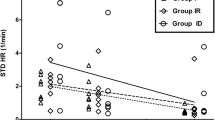Abstract
Amphibians are commonly used in biomedical research, including studies of mechanisms of anaesthetic action. There is, however, little published work describing the kinetics of inhaled anaesthetic agents or the potency of isoflurane in amphibians. Ten Northern leopard frogs were exposed to a constant isoflurane concentration of 1.0%, 1.2% or 1.5% atm for 4 h, and their response to a noxious stimulus was tested every 20 min. Each frog was anaesthetized with each concentration in random order and allowed at least 16 h to recover between anaesthetic exposures. Frogs were then pithed and the protocol was repeated. Frogs first displayed immobility during stimulus application at 80 min, and the proportion of animals becoming immobile steadily increased to reach a stable level at 4 h. The 50% effective dose for isoflurane in intact and pithed frogs did not differ, and was 1.15 and 1.25% atm, respectively. The potency of isoflurane in leopard frogs was similar to that reported in mammalian species. Cutaneous uptake of anaesthetic is effective given sufficient time, approximately 4 h in this study. Forebrain structures appear to be unimportant for the immobilizing action of isoflurane in the frog.
Similar content being viewed by others
Abbreviations
- ED50 :
-
50% effective dose
- MAC:
-
minimum alveolar concentration
References
Antognini, J.F. and Schwartz, K., 1993. Exaggerated anesthetic requirements in the preferentially anesthetized brain. Anesthesiology, 79, 1244–1249
Barter, L.S., Hawkins, M.G., Brosnan, R.J., Antognini, J.F. and Pypendop, B.H., 2006. Median effective dose of isoflurane, sevoflurane, and desflurane in green iguanas. American Journal of Veterinary Research, 67, 392–397
Cakir, Y. and Strauch, S.M., 2005. Tricaine (MS-222) is a safe anesthetic compound compared to benzocaine and pentobarbital to induce anesthesia in leopard frogs (Rana pipiens). Pharmacological Reports, 57, 467–474
Cherkin, A. and Catchpool, J.F., 1964. Temperature dependence of anesthesia in goldfish. Science, 144, 1460–1462
DeLong, K.T., 1962. Quantitative analysis of blood circulation through the frog heart. Science, 138, 693–694
Eger, E.I., 1974. MAC. In: Anesthetic Uptake and Action, (Williams & Wilkins, Baltimore), 1–25
Moalli, R., Meyers, R.S., Jackson, D.C. and Millard, R.W., 1980. Skin circulation of the frog, Rana catasbeiana: distribution and dynamics. Respiration Physiology, 40, 137–148
Pinder, A.W. and Burggen, W.W., 1986. Ventilation and partitioning of oxygen uptake in the frog Rana pipiens: effects of hypoxia and activity. Journal of Experimental Biology, 126, 453–468
Quasha, A.L., Eger, E.I. and Tinker, J.H., 1980. Determination and applications of MAC. Anesthesiology, 53, 315–334
Rampil, I.J., Mason, P. and Singh, H., 1993. Anesthetic potency (MAC) is independent of forebrain structures in the rat. Anesthesiology, 78, 707–712
Shim, C.Y. and Andersen, N.B., 1971. The effect of oxygen on minimal anesthetic requirements in the toad. Anesthesiology, 34, 333–337
Shim, C.Y. and Andersen, N.B., 1972. Minimal alveolar concentration (MAC) and dose–response curves in anesthesia. Anesthesiology, 36, 146–151
Smith, J.N. and Stump, K.C., 2000. Isoflurane anesthesia in the African clawed frog (Xenopus laevis). Contemporary Topics in Laboratory Animal Science, 39, 39–42
Stahl, W.R., 1967. Scaling of respiratory variables in mammals. Journal of Applied Physiology, 22, 453–460
Steffey, E.P. and Howland, D., 1977. Isoflurane potency in the dog and cat. American Journal of Veterinary Research, 38, 1833–1836
Steffey, E.P., Howland, D., Jr, Giri, S. and Eger, E.I., II, 1977. Enflurane, halothane, and isoflurane potency in horses. American Journal of Veterinary Research, 38, 1037–1039
Stevens, W.C., Dolan, W.M., Gibbons, R.D., White, A., Eger, E.I., II, Miller, R.D., De Jong, R.H. and Elashoff, R.M., 1975. Minimum alveolar concentrations (MAC) of isoflurane with and without nitrous oxide in patients of various ages. Anesthesiology, 42, 197–200
Tazawa, H., Mochizuki, M., Piiper, J., 1979. Respiratory gas transport by the incompletely separated double circulation in the bullfrog, Rana catesbeiana. Respiration Physiology, 36, 77–95
Vitez, T.S., White, P.F. and Eger, E.I., 1974. Effects of hypothermia on halothane MAC and isoflurane MAC in the rat. Anesthesiology, 41, 80–81
Wass, J.A. and Kaplan, H.M., 1974. Methoxyflurane anesthesia for Rana pipiens. Laboratory Animal Science, 24, 669–671
Author information
Authors and Affiliations
Corresponding author
Rights and permissions
About this article
Cite this article
Barter, L.S., Mark, L.O., Smith, A.C. et al. Isoflurane Potency in the Northern Leopard Frog Rana pipiens is Similar to That in Mammalian Species and is Unaffected by Decerebration. Vet Res Commun 31, 757–763 (2007). https://doi.org/10.1007/s11259-007-0077-5
Accepted:
Published:
Issue Date:
DOI: https://doi.org/10.1007/s11259-007-0077-5




